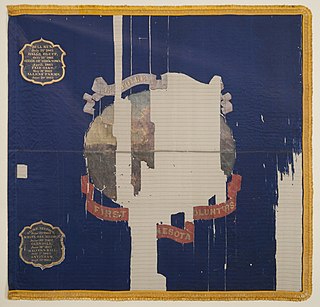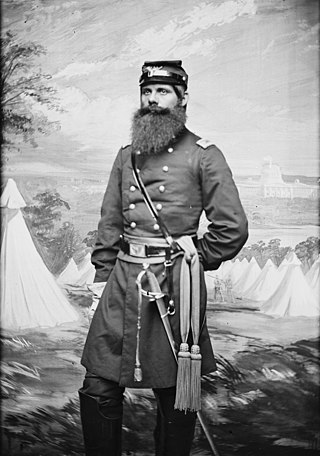
The 1st Minnesota Infantry Regiment was a Union infantry regiment active during the American Civil War. The 1st Minnesota participated in the battles of First Bull Run, Antietam and the Battle of Gettysburg. The regiment's most famous action occurred on the second day of the Battle of Gettysburg when Major General Winfield Scott Hancock ordered the 1st Minnesota to charge into a brigade of 1200 Confederate soldiers. This action blunted the Confederate attack and helped preserve the Union's precarious position on Cemetery Ridge.

The 2nd Wisconsin Infantry Regiment was an infantry regiment that served in the Union Army during the American Civil War. It spent most of the war as a member of the famous Iron Brigade of the Army of the Potomac. It suffered the largest number of casualties as a percentage of its total enlistment of any Union Army unit in the war.
The 7th Wisconsin Infantry Regiment was an infantry regiment that served in the Union Army during the American Civil War. It was a component of the famous Iron Brigade in the Army of the Potomac throughout the war.

The 4th Michigan Infantry Regiment was an infantry regiment that served in the Union Army during the American Civil War. The 4th Michigan wore a very Americanized zouave uniform. This uniform consisted of a Federal dark blue 4 button sack coat, dark blue chasseur trousers, tan gaiters, and a maroon zouave fez with a light blue tassel.
The Thirteenth Pennsylvania Reserve Regiment, also known as the 42nd Pennsylvania Volunteer Infantry, the 1st Pennsylvania Rifles, Kane's Rifles, or simply the "Bucktails," was a volunteer infantry regiment that served in the Union Army during the American Civil War. It was a part of the famed Pennsylvania Reserve division in the Army of the Potomac for much of the early and middle parts of the war, and served in the Eastern Theater in a number of important battles, including Antietam, Fredericksburg, and Gettysburg.

The 2nd Regiment Massachusetts Volunteer Infantry was an infantry regiment in the Union Army during the American Civil War. Major George H. Gordon, a West Point graduate and veteran of the Mexican–American War, organized the unit's recruitment and formation. The 2nd Massachusetts was trained at Camp Andrew in West Roxbury, Massachusetts on the site of the former Transcendentalist utopian community, Brook Farm. Roughly half the regiment was mustered in on May 18, 1861 and the remainder on May 25, 1861 for a term of three years. The regiment saw extensive combat as part of the Army of the Potomac particularly during the Battle of Antietam and the Battle of Gettysburg.

The 5th New Hampshire Infantry Regiment was an infantry regiment that served in the Union Army during the American Civil War. The regiment has the unfortunate distinction of having sustained the greatest total loss in battles of any infantry or cavalry regiment in the Union Army, with a total of 295 killed and 756 wounded, for a total of 1,051 men.
Daniel Woodall (1841-1880) was an American Union army officer during the period of the American Civil War. He served in the 1st Delaware Infantry Regiment, and fought in the Eastern Theater.

The 61st New York Infantry Regiment, also known as the "Astor Regiment", was an infantry regiment of the Union Army during the American Civil War.

The 82nd New York Infantry Regiment, the "Second Militia," "Second Regiment N. Y. S. Light Infantry," or "State Guards", was an infantry regiment of the Union Army during the American Civil War.

The 80th New York Infantry Regiment, originally designated the 20th New York State Militia Regiment, "Ulster Guard", was an infantry regiment of the Union Army during the American Civil War.

The 83rd New York Infantry Regiment, the "Ninth Militia," "Ninth Infantry National Guard," or "City Guard", was an infantry regiment of the Union Army during the American Civil War.

The 57th New York Infantry Regiment was an infantry regiment in the Union Army during the American Civil War.

The 66th New York Infantry Regiment was an infantry regiment in the Union Army during the American Civil War.
The 2nd Delaware Infantry Regiment was an infantry regiment in the Union Army during the American Civil War.
The 5th Maryland Volunteer Infantry Regiment was an infantry regiment that served in the Union Army during the American Civil War.

The 1st Pennsylvania Reserve Regiment, also known as the 30th Pennsylvania Volunteer Infantry, was a regiment in the Union Army during the American Civil War. It was a part of the famed Pennsylvania Reserve division in the Army of the Potomac for much of the war, and served in the Eastern Theater in a number of important battles, including Antietam, Fredericksburg, and Gettysburg.

The 100th Regiment Pennsylvania Volunteer Infantry was an infantry regiment that served in the Union Army during the American Civil War.
The 128th Pennsylvania Volunteer Infantry was an infantry regiment that served in the Union Army during the American Civil War.

The 111th Pennsylvania Volunteer Infantry was an infantry regiment that served in the Union Army during the American Civil War. It was noted for its holding the high ground at the center of the line at Antietam as part of Stainrook's 2nd Brigade, Greene's 2nd Division of Mansfield's XII Corps.










